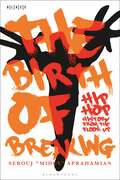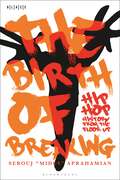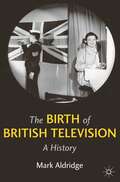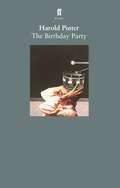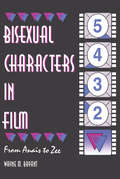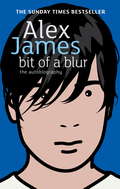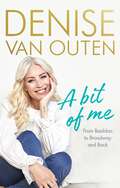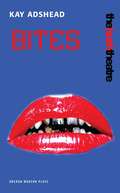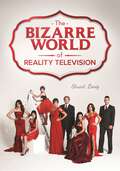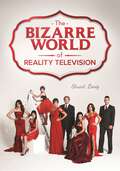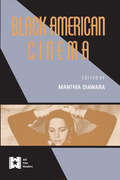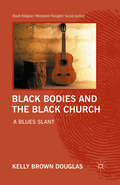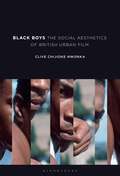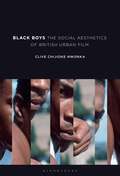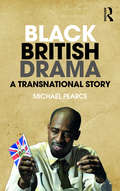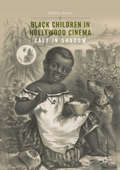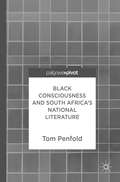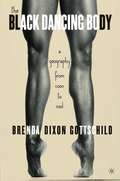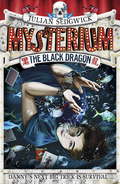- Table View
- List View
The Birth of Breaking: Hip-Hop History from the Floor Up (Black Literary and Cultural Expressions)
by Serouj "Midus" AprahamianThe untold story of how breaking – one of the most widely practiced dance forms in the world today – began as a distinctly African American expression in the Bronx, New York, during the 1970s. Breaking is the first and most widely practiced hip-hop dance in the world, with around one million participants in this dynamic, multifaceted artform – and, as of 2024, Olympic sport. Yet, despite its global reach and nearly 50-year history, stories of breaking's origins have largely neglected the African Americans who founded it. Dancer and scholar Serouj "Midus" Aprahamian offers, for the first time, a detailed look into the African American beginnings of breaking in the Bronx, New York. The Birth of Breaking challenges numerous myths and misconceptions that have permeated studies of hip-hop's evolution, considering the influence breaking has had on hip-hop culture. Including previously unseen archival material, interviews, and detailed depictions of the dance at its outset, this book brings to life this buried history, with a particular focus on the early development of the dance, the institutional settings where hip-hop was conceived, and the movement's impact on sociocultural conditions in New York City throughout the 1970s. By featuring the overlooked first-hand accounts of over 50 founding b-boys and b-girls alongside movement analysis informed by his embodied knowledge of the dance, Aprahamian reveals how indebted breaking is to African American culture, as well as the disturbing factors behind its historical erasure.
The Birth of Breaking: Hip-Hop History from the Floor Up (Black Literary and Cultural Expressions)
by Serouj "Midus" AprahamianThe untold story of how breaking – one of the most widely practiced dance forms in the world today – began as a distinctly African American expression in the Bronx, New York, during the 1970s. Breaking is the first and most widely practiced hip-hop dance in the world, with around one million participants in this dynamic, multifaceted artform – and, as of 2024, Olympic sport. Yet, despite its global reach and nearly 50-year history, stories of breaking's origins have largely neglected the African Americans who founded it. Dancer and scholar Serouj "Midus" Aprahamian offers, for the first time, a detailed look into the African American beginnings of breaking in the Bronx, New York. The Birth of Breaking challenges numerous myths and misconceptions that have permeated studies of hip-hop's evolution, considering the influence breaking has had on hip-hop culture. Including previously unseen archival material, interviews, and detailed depictions of the dance at its outset, this book brings to life this buried history, with a particular focus on the early development of the dance, the institutional settings where hip-hop was conceived, and the movement's impact on sociocultural conditions in New York City throughout the 1970s. By featuring the overlooked first-hand accounts of over 50 founding b-boys and b-girls alongside movement analysis informed by his embodied knowledge of the dance, Aprahamian reveals how indebted breaking is to African American culture, as well as the disturbing factors behind its historical erasure.
The Birth of British Television: A History
by M. AldridgeWhen the BBC launched the world's first regular, high-definition television service on 2 November, 1936 it was the culmination of decades of technological innovations. More than this, however, the service meant that the principle of television had finally found its place. The Birth of British Television – A History traces the early history and development of television, from the experiments of amateurs to the institutionalised developments that led to the world's first regular, high definition television service. Author Mark Aldridge provides a clear, in-depth and accessible introduction for those either exploring the period for the first time or seeking new insights into the beginnings of the industry. In tracing the origins and development of television, Aldridge focuses on a number of important factors including the attitude of the press towards early television and examines the way that expectations of television changed over time prior to its official launch. Utilising new research, this illuminating study examines how the aims for a new television service developed, and the extent to which content and technology were linked. The Birth of British Television approaches this formative period from several perspectives, from private individuals to the BBC and government, while also examining the broader opinions at the time towards the new medium through press reports and feedback from the general public. Also included is an assessment of early programming, which helps to offer a new and profound evaluation of the development of early television. Mark Aldridge is a Lecturer in Film and TV Studies at Southampton Solent University, UK. He specialises in British television and both film and television history. His previous publications include T is for Television (2008), an analysis of the work of Russell T. Davies, co-written with Andy Murray.
The Birthday Party: The Birthday Party; The Room; The Dumb Waiter; A Slight Ache; The Hothouse; A Night Out; The Black And White; The Examination (Pinter, Harold Ser.)
by Harold PinterStanley Webber is visited in his boarding house by strangers, Goldberg and McCann. An innocent-seeming birthday party for Stanley turns into a nightmare.The Birthday Party was first performed in 1958 and is now a modern classic, produced and studied throughout the world.
Bisexual Characters in Film: From Ana's to Zee
by Wayne M BryantHow far have we progressed from the days when showing a film such as Jack Smith’s Flaming Creatures landed the cinema’s programmer, projectionist, and ticket taker in jail? What are some of the hidden clues modern audiences are overlooking in older films that suggest a character’s bisexuality? Which famous actors, actresses, directors, and screenwriters were attracted to people of both sexes? In Bisexual Characters in Film, the first book to focus on the role of bisexual characters in film, you’ll find answers to these questions and many more as you explore, analyze, and celebrate 80 years of bisexual movie characters (and the people who have created them) from around the world. A lively, entertaining, and informative commentary, this book examines the treatment of bisexual film characters and shows you how that treatment has been affected by societal forces such as censorship, politics, religious prejudices, homophobia, and sexual stereotypes. Bisexual Characters in Film looks at the contribution of bisexual people (and others who have had lovers of varying sexes) to the body of work available on film today. These include the directors, writers, actors, composers, and designers whose sexual orientation has informed their work. An analysis of the Motion Picture Production Code and its devastating effect on bisexual and homosexual screen images forms an important part of the book. You learn how, specifically, it eradicated gay, lesbian, and bisexual characters from Hollywood films as well as the role of bisexual, lesbian, and gay filmmakers in finally defeating it. Other questions you’ll find answers to include: Who, or what, is a bisexual? How were bisexual characters represented in silent film, before the forces of censorship banned them from the screen? What bisexual myths and stereotypes are portrayed on film? What is the role of “camp” in bisexual film?Bisexual Characters in Film is a unique resource for researchers; librarians; film festival planners; the queer media; professors and students of lesbian, gay, and bisexual studies; bisexual activists; and general bisexual, gay, lesbian, and transgendered readers. It provides a much-needed view of bisexual representations in a major segment of our popular culture.
Bisexual Characters in Film: From Ana's to Zee
by Wayne M BryantHow far have we progressed from the days when showing a film such as Jack Smith’s Flaming Creatures landed the cinema’s programmer, projectionist, and ticket taker in jail? What are some of the hidden clues modern audiences are overlooking in older films that suggest a character’s bisexuality? Which famous actors, actresses, directors, and screenwriters were attracted to people of both sexes? In Bisexual Characters in Film, the first book to focus on the role of bisexual characters in film, you’ll find answers to these questions and many more as you explore, analyze, and celebrate 80 years of bisexual movie characters (and the people who have created them) from around the world. A lively, entertaining, and informative commentary, this book examines the treatment of bisexual film characters and shows you how that treatment has been affected by societal forces such as censorship, politics, religious prejudices, homophobia, and sexual stereotypes. Bisexual Characters in Film looks at the contribution of bisexual people (and others who have had lovers of varying sexes) to the body of work available on film today. These include the directors, writers, actors, composers, and designers whose sexual orientation has informed their work. An analysis of the Motion Picture Production Code and its devastating effect on bisexual and homosexual screen images forms an important part of the book. You learn how, specifically, it eradicated gay, lesbian, and bisexual characters from Hollywood films as well as the role of bisexual, lesbian, and gay filmmakers in finally defeating it. Other questions you’ll find answers to include: Who, or what, is a bisexual? How were bisexual characters represented in silent film, before the forces of censorship banned them from the screen? What bisexual myths and stereotypes are portrayed on film? What is the role of “camp” in bisexual film?Bisexual Characters in Film is a unique resource for researchers; librarians; film festival planners; the queer media; professors and students of lesbian, gay, and bisexual studies; bisexual activists; and general bisexual, gay, lesbian, and transgendered readers. It provides a much-needed view of bisexual representations in a major segment of our popular culture.
Bit Of A Blur: The Autobiography
by Alex JamesI was the Fool-king of Soho and the number-one slag in the Groucho Club, the second drunkest member of the world's drunkest band. This was no disaster, though. It was a dream coming true.'For Alex James, music had always been a door to a more eventful life. But as bass player of Blur - one of the most successful British bands of all time - his journey was more exciting and extreme than he could ever have predicted. In Bit of a Blur he chronicles his journey from a slug-infested flat in Camberwell to a world of screaming fans and private jets - and his eventual search to find meaning and happiness (and, perhaps most importantly, the perfect cheese), in an increasingly surreal world.
A Bit of Me: From Basildon to Broadway, and back
by Denise Van OutenDenise Van Outen, original 90s 'ladette', West End star and primetime TV favourite, reveals for the first time the true story of grit and graft beneath the famous Essex sparkle.In this refreshingly candid memoir, Denise speaks openly and sensitively about her rollercoaster career, her struggles in a past high-profile relationship and the betrayal she suffered at the hands of those once closest to her, with the hope that in doing so, she can help empower others to avoid and overcome any similar difficulties they may face.Denise shot to fame on The Big Breakfast in her early twenties. After a decade grafting through theatre jobs and children's TV shows, she was finally living the dream. However her life soon turned into a nightmare off-screen and behind the headlines as her heart was broken in a very public relationship, whilst her every move was printed in the tabloids thanks to her phone being tapped. After receiving a panning by the critics for her late night TV show aimed at the post-pub crowd, she then auditioned for and accepted an offer to play Roxie Hart in Chicago, which turned out to be a life-changing experience. The role took her to Broadway, where she caught the eye of one Andrew Lloyd Webber, eventually landing a judging role on Any Dream Will Do, which saw her rise back to primetime and the career that she loves, where she has stayed and flourished. Now, in her first memoir, Denise tells her story with disarming candour, unafraid to reveal vulnerabilities beneath the cheerful exterior. Tackling difficult subjects of corrosive self-doubt, betrayal, invasions of privacy and professional struggles, interjected with the familiar humour that we all know and love, A Bit of Me is personal, at times raw, often mischievous and always compelling. Denise has lived the life, learned the lessons, and Basildon to Broadway and back is a hell of a journey.
Bites (Oberon Modern Plays Ser.)
by Kay AdsheadMoving from the biggest democracy on the planet to the newest, Bites takes us back to Afghanistan via Texas. In the last diner at the end of a world ravaged by war, a menu of love, death and revenge is served by the ‘hired help'. Seven courses make for a poetic feast of universal tales looking back to the forgotten war and forward to a nightmarish future.Produced at the Bush Theatre, London in January 2005 (Mama Quillo in association with The Bush).
The Bizarre World of Reality Television
by Stuart LenigHow do reality television programs shape our view of the world and what we perceive as real and normal? This book explores the bizarre and highly controversial world of reality television, including its early history, wide variety of subject matter, and social implications.In recent decades, reality television shows ranging from Keeping up with the Kardashians to Duck Dynasty have become increasingly popular. Why are these "unscripted" programs irresistible to millions of viewers? And what does the nearly universal success of reality shows say about American culture? This book covers more than 100 major and influential reality programs past and present, discussing the origins and past of reality programming, the contemporary social and economic conditions that led to the rise of reality shows, and the ways in which the most successful shows achieve popularity with both male and female demographics or appeal to specific, targeted niche audiences.The text addresses reality TV within five, easy-to-identify content categories: competition shows, relationship/love-interest shows, real people or alternative lifestyle and culture shows, transformation shows, and international programming. By examining modern reality television, a topic of great interest for a wide variety of readers, this book also discusses cultural and social norms in the United States, including materialism, unrealistic beauty ideals, gender roles and stereotypes in society, dynamics of personal relationships, teenage lifestyles and issues, and the branding of people for financial gain and wider viewership.
The Bizarre World of Reality Television
by Stuart LenigHow do reality television programs shape our view of the world and what we perceive as real and normal? This book explores the bizarre and highly controversial world of reality television, including its early history, wide variety of subject matter, and social implications.In recent decades, reality television shows ranging from Keeping up with the Kardashians to Duck Dynasty have become increasingly popular. Why are these "unscripted" programs irresistible to millions of viewers? And what does the nearly universal success of reality shows say about American culture? This book covers more than 100 major and influential reality programs past and present, discussing the origins and past of reality programming, the contemporary social and economic conditions that led to the rise of reality shows, and the ways in which the most successful shows achieve popularity with both male and female demographics or appeal to specific, targeted niche audiences.The text addresses reality TV within five, easy-to-identify content categories: competition shows, relationship/love-interest shows, real people or alternative lifestyle and culture shows, transformation shows, and international programming. By examining modern reality television, a topic of great interest for a wide variety of readers, this book also discusses cultural and social norms in the United States, including materialism, unrealistic beauty ideals, gender roles and stereotypes in society, dynamics of personal relationships, teenage lifestyles and issues, and the branding of people for financial gain and wider viewership.
Black American Cinema
by Manthia DiawaraThis is the first major collection of criticism on Black American cinema. From the pioneering work of Oscar Micheaux and Wallace Thurman to the Hollywood success of Spike Lee, Black American filmmakers have played a remarkable role in the development of the American film, both independent and mainstream.In this volume, the work of early Black filmmakers is given serious attention for the first time. Individual essays consider what a Black film tradition might be, the relation between Black American filmmakers and filmmakers from the diaspora, the nature of Black film aesthetics, the artist's place within the community, and the representation of a Black imaginary. Black American Cinema also uncovers the construction of Black sexuality on screen, the role of Black women in independent cinema, and the specific question of Black female spectatorship. A lively and provocative group of essays debate the place and significance of Spike LeeOf crucial importance are the ways in which the essays analyze those Black directors who worked for Hollywood and whose films are simplistically dismissed as sell-outs, to the Hollywood "master narrative," as well as those "crossover" filmmakers whose achievements entail a surreptitious infiltration of the studios. Black American Cinema demonstrates the wealth of the Black contribution to American film and the complex course that contribution has taken.Contributors: Houston Baker, Jr., Toni Cade Bambara, Amiri Baraka, Jacquie Bobo, Richard Dyer, Jane Gaines, Henry Louis Gates, Jr., Ron Green, Ed Guerrero, bell hooks, Phyllis Klotman, Ntongele Masilela, Clyde Taylor, and Michele Wallace.
Black American Cinema
by Manthia DiawaraThis is the first major collection of criticism on Black American cinema. From the pioneering work of Oscar Micheaux and Wallace Thurman to the Hollywood success of Spike Lee, Black American filmmakers have played a remarkable role in the development of the American film, both independent and mainstream.In this volume, the work of early Black filmmakers is given serious attention for the first time. Individual essays consider what a Black film tradition might be, the relation between Black American filmmakers and filmmakers from the diaspora, the nature of Black film aesthetics, the artist's place within the community, and the representation of a Black imaginary. Black American Cinema also uncovers the construction of Black sexuality on screen, the role of Black women in independent cinema, and the specific question of Black female spectatorship. A lively and provocative group of essays debate the place and significance of Spike LeeOf crucial importance are the ways in which the essays analyze those Black directors who worked for Hollywood and whose films are simplistically dismissed as sell-outs, to the Hollywood "master narrative," as well as those "crossover" filmmakers whose achievements entail a surreptitious infiltration of the studios. Black American Cinema demonstrates the wealth of the Black contribution to American film and the complex course that contribution has taken.Contributors: Houston Baker, Jr., Toni Cade Bambara, Amiri Baraka, Jacquie Bobo, Richard Dyer, Jane Gaines, Henry Louis Gates, Jr., Ron Green, Ed Guerrero, bell hooks, Phyllis Klotman, Ntongele Masilela, Clyde Taylor, and Michele Wallace.
Black Bodies and the Black Church: A Blues Slant (Black Religion/Womanist Thought/Social Justice)
by Kelly Brown DouglasBlues is absolutely vital to black theological reflection and to the black church's existence. In Black Bodies and the Black Church , author Kelly Douglas Brown develops a blues crossroad theology, which allows the black church to remain true to itself and relevant in black lives.
Black Boys: The Social Aesthetics of British Urban Film
by Clive Chijioke NwonkaIn Black Boys: The Aesthetics of British Urban Film, Nwonka offers the first dedicated analysis of Black British urban cinematic and televisual representation as a textual encounter with Blackness, masculinity and urban identity where the generic construction of images and narratives of Black urbanity is informed by the (un)knowable allure of Black urban Otherness. Foregrounding the textual Black urban identity as a historical formation, and drawing on a range of theoretical frameworks that allow for an examination of the emergence and continued social, cultural and industrial investment in the fictitious and non-fictitious images of Black urban identities and geographies, Nwonka convenes a dialogue between the disciplines of Film and Television Studies, Philosophy, Cultural Studies, Black Studies, Sociology and Criminology. Here, Nwonka ventures beyond what can be understood as the perennial and simplistic optic of racial stereotype in order to advance a more expansive reading of the Black British urban text as the outcome of a complex conjunctural interaction between social phenomena, cultural policy, political discourse and the continuously shifting politics of Black representation. Through the analysis of a number of texts and political and socio-cultural moments, Nwonka identifies Black urban textuality as conditioned by a bidirectionality rooted in historical and contemporary questions of race, racism and anti-Blackness but equally attentive to the social dynamics that render the screen as a site of Black recognition, authorship and authenticity. Analysed in the context of realism, social and political allegory, urban multiculture, Black corporeality and racial, gender and sexual politics, in integrating such considerations into the fabrics of a thematic reading of the Black urban text and through the writings of Stuart Hall, Paul Gilroy, Judith Butler and Derrida, Black Boys presents a critical rethinking of the contextual and aesthetic factors in the visual constructions of Black urban identity.
Black Boys: The Social Aesthetics of British Urban Film
by Clive Chijioke NwonkaIn Black Boys: The Aesthetics of British Urban Film, Nwonka offers the first dedicated analysis of Black British urban cinematic and televisual representation as a textual encounter with Blackness, masculinity and urban identity where the generic construction of images and narratives of Black urbanity is informed by the (un)knowable allure of Black urban Otherness. Foregrounding the textual Black urban identity as a historical formation, and drawing on a range of theoretical frameworks that allow for an examination of the emergence and continued social, cultural and industrial investment in the fictitious and non-fictitious images of Black urban identities and geographies, Nwonka convenes a dialogue between the disciplines of Film and Television Studies, Philosophy, Cultural Studies, Black Studies, Sociology and Criminology. Here, Nwonka ventures beyond what can be understood as the perennial and simplistic optic of racial stereotype in order to advance a more expansive reading of the Black British urban text as the outcome of a complex conjunctural interaction between social phenomena, cultural policy, political discourse and the continuously shifting politics of Black representation. Through the analysis of a number of texts and political and socio-cultural moments, Nwonka identifies Black urban textuality as conditioned by a bidirectionality rooted in historical and contemporary questions of race, racism and anti-Blackness but equally attentive to the social dynamics that render the screen as a site of Black recognition, authorship and authenticity. Analysed in the context of realism, social and political allegory, urban multiculture, Black corporeality and racial, gender and sexual politics, in integrating such considerations into the fabrics of a thematic reading of the Black urban text and through the writings of Stuart Hall, Paul Gilroy, Judith Butler and Derrida, Black Boys presents a critical rethinking of the contextual and aesthetic factors in the visual constructions of Black urban identity.
Black British Drama: A Transnational Story
by Michael PearceBlack British Drama: A Transnational Story looks afresh at the ways black theatre in Britain is connected to and informed by the spaces of Africa, the Caribbean and the USA. Michael Pearce offers an exciting new approach to reading modern and contemporary black British drama, examining plays by a range of writers including Michael Abbensetts, Mustapha Matura, Caryl Phillips, Winsome Pinnock, Kwame Kwei-Armah, debbie tucker green, Roy Williams and Bola Agbaje. Chapters combine historical documentation and discussion with close analysis to provide an in-depth, absorbing account of post-war black British drama situated within global and transnational circuits. A significant contribution to black British and black diaspora theatre studies, Black British Drama is a must-read for scholars and students in this evolving field.
Black British Drama: A Transnational Story
by Michael PearceBlack British Drama: A Transnational Story looks afresh at the ways black theatre in Britain is connected to and informed by the spaces of Africa, the Caribbean and the USA. Michael Pearce offers an exciting new approach to reading modern and contemporary black British drama, examining plays by a range of writers including Michael Abbensetts, Mustapha Matura, Caryl Phillips, Winsome Pinnock, Kwame Kwei-Armah, debbie tucker green, Roy Williams and Bola Agbaje. Chapters combine historical documentation and discussion with close analysis to provide an in-depth, absorbing account of post-war black British drama situated within global and transnational circuits. A significant contribution to black British and black diaspora theatre studies, Black British Drama is a must-read for scholars and students in this evolving field.
The Black British Quiz Book
by PrtyhereDive into this fun and entertaining quiz book from the UK’s biggest Black British pub quiz!
Black Children in Hollywood Cinema: Cast in Shadow
by Debbie OlsonThis book explores cultural conceptions of the child and the cinematic absence of black children from contemporary Hollywood film. Debbie Olson argues that within the discourse of children’s studies and film scholarship in relation to the conception of “the child,” there is often little to no distinction among children by race—the “child” is most often discussed as a universal entity, as the embodiment of all things not adult, not (sexually) corrupt. Discussions about children of color among scholars often take place within contexts such as crime, drugs, urbanization, poverty, or lack of education that tend to reinforce historically stereotypical beliefs about African Americans. Olson looks at historical conceptions of childhood within scholarly discourse, the child character in popular film and what space the black child (both African and African American) occupies within that ideal.
Black Children in Hollywood Cinema: Cast in Shadow
by Debbie OlsonThis book explores cultural conceptions of the child and the cinematic absence of black children from contemporary Hollywood film. Debbie Olson argues that within the discourse of children’s studies and film scholarship in relation to the conception of “the child,” there is often little to no distinction among children by race—the “child” is most often discussed as a universal entity, as the embodiment of all things not adult, not (sexually) corrupt. Discussions about children of color among scholars often take place within contexts such as crime, drugs, urbanization, poverty, or lack of education that tend to reinforce historically stereotypical beliefs about African Americans. Olson looks at historical conceptions of childhood within scholarly discourse, the child character in popular film and what space the black child (both African and African American) occupies within that ideal.
Black Consciousness and South Africa’s National Literature
by Tom PenfoldThis book analyses Black Consciousness poetry and theatre from the 1970s through to the present. South Africa’s literature, like its history, has been beset by disagreement and contradiction, and has been consistently difficult to pin down as one, united entity. Much existing criticism on South Africa’s national literature has attempted to overcome these divisions by discussing material written from a variety of different subject positions together. This book argues that Black Consciousness desired a new South Africa where African and European cultures were valued equally, and writers could represent both as they wished. Thus, a body of literature was created that addressed a range of audiences and imagined the South African nation in different ways. This book explores Black Consciousness in order to demonstrate how South African writers have responded in various ways to the changing history and politics of their country.
Black Consciousness and South Africa’s National Literature
by Tom PenfoldThis book analyses Black Consciousness poetry and theatre from the 1970s through to the present. South Africa’s literature, like its history, has been beset by disagreement and contradiction, and has been consistently difficult to pin down as one, united entity. Much existing criticism on South Africa’s national literature has attempted to overcome these divisions by discussing material written from a variety of different subject positions together. This book argues that Black Consciousness desired a new South Africa where African and European cultures were valued equally, and writers could represent both as they wished. Thus, a body of literature was created that addressed a range of audiences and imagined the South African nation in different ways. This book explores Black Consciousness in order to demonstrate how South African writers have responded in various ways to the changing history and politics of their country.
The Black Dancing Body: A Geography From Coon to Cool
by B. GottschildWhat is the essence of black dance in America? To answer that question, Brenda Dixon Gottschild maps an unorthodox 'geography', the geography of the black dancing body, to show the central place black dance has in American culture. From the feet to the butt, to hair to skin/face, and beyond to the soul/spirit, Brenda Dixon Gottschild talks to some of the greatest choreographers of our day including Garth Fagan, Francesca Harper, Meredith Monk, Brenda Buffalino, Doug Elkins, Ralph Lemon, Fernando Bujones, Bill T. Jones, Trisha Brown, Jawole Zollar, Bebe Miller, Sean Curran and Shelly Washington to look at the evolution of black dance and it's importance to American culture. This is a groundbreaking piece of work by one of the foremost African-American dance critics of our day.
The Black Dragon: Book 1 (Mysterium #1)
by Julian SedgwickEast meets West; past meets present; criminal minds meet skilled artists - welcome to the Mysterium, a circus with dark and thrilling secrets at its heart.Twelve-year-old Danny Woo is half-Chinese, half-British. His parents are performers in the Mysterium. Following their death in a mysterious fire, Danny is sent to live with his aunt Laura, an investigative journalist.When Danny's school is closed after an explosion, he joins Laura on a trip to Hong Kong. She is researching the Triad gangs; he is trying to understand more about his cultural background.But Laura disappears, and Danny is plunged into a dangerous quest to find her - which opens the door on the past he could never have imagined, and which leads him to question everything he has ever known about his past.
